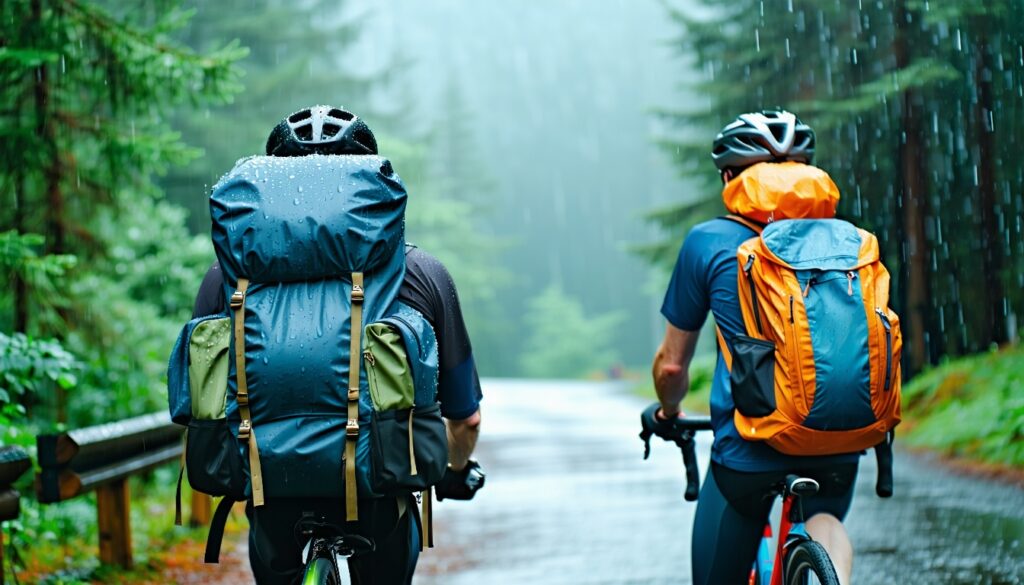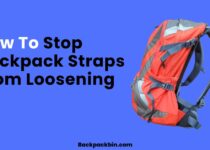When to Add Rain Covers or Dry Bags to Your Bike Backpack

Essential Features for Cycling Backpacks
Choosing the right cycling backpack can significantly enhance the riding experience, especially when dealing with varying weather conditions. Here are the essential features to consider when selecting a cycling backpack.
Waterproof Materials
One of the most crucial factors for a cycling backpack is its material. Backpacks made from durable and waterproof fabrics ensure excellent water resistance, particularly in heavy rain. High-quality materials include PVC-coated nylon, TPU (thermoplastic polyurethane), and laminated fabrics. These materials not only provide waterproof properties but also offer durability for long-term use.
| Material Type | Waterproof Rating (mm) | UV Resistance | Durability |
|---|---|---|---|
| PVC-Coated Nylon | 1000 – 5000 | Moderate | High |
| TPU | 3000 – 10000 | High | Very High |
| Laminated Fabrics | 2000 – 8000 | Moderate | High |
For more details on how to select the right material, explore our article on waterproof vs water-resistant: choosing bike-safe backpacks.
Seam Construction
The construction of the seams is vital in determining the waterproof capability of a backpack. It is advisable to choose backpacks with welded seams rather than stitched seams. Welded seams use heat-sealing techniques to create a watertight bond, preventing water from seeping through and compromising the backpack’s waterproof features. This design is essential for cyclists who may encounter wet conditions during their rides.
For further information on seam types and their importance, check out our insights on how to clean a cycling backpack after rainy rides.
Roll-Top Closure
Many waterproof backpacks feature a roll-top closure design that creates a watertight seal. This feature is particularly important for cyclists as it prevents water from entering the main compartment during unexpected rain. Roll-top closures allow for volume adjustment and can accommodate varying load sizes, which is beneficial for cyclists carrying different gear.
| Closure Type | Water Resistance | Load Adjustment | Popularity |
|---|---|---|---|
| Roll-Top | Excellent | Yes | Very High |
| Zippered | Moderate | Moderate | High |
| Velcro | Low | Moderate | Moderate |
To delve deeper into the benefits of roll-top backpacks, refer to our discussion on Should you use a roll-top backpack for urban cycling?.
Selecting a cycling backpack with these essential features ensures that riders can confidently face different weather conditions, making their cycling experience much more enjoyable and worry-free.
Comfort and Support
When cycling, comfort and support are key factors in choosing a backpack that enhances the riding experience. Padded shoulder straps and waist and chest straps contribute significantly to how comfortable a cyclist feels while riding.
Padded Shoulder Straps
Padded shoulder straps are an essential feature in cycling backpacks. They help reduce pressure on the shoulders and prevent discomfort during extended wear. The cushioning provides a more comfortable fit, especially on longer rides, which can be critical for cyclists of any age. Many backpacks come with adjustable straps that allow for a customized fit to ensure optimal comfort.
| Feature | Benefits |
|---|---|
| Adjustable Length | Ensures a personalized fit |
| Padding Thickness | Reduces pressure, enhances comfort |
Waist and Chest Straps
Including waist and chest straps in a cycling backpack can greatly improve stability and support during rides. Waist straps help stabilize the backpack, distributing weight evenly across the body, which can reduce strain on the back and shoulders. Chest straps improve stability and balance, keeping the backpack from shifting while cycling.
| Strap Type | Function | Benefits |
|---|---|---|
| Waist Straps | Stabilize and distribute weight | Reduce back and shoulder strain |
| Chest Straps | Enhance stability and balance | Prevent shifting during movement |
Choosing a backpack with these features can enhance comfort and support on the bike. For cyclists considering options for hydration, you might like our piece on hydration-compatible cycling backpacks: what to look for. It’s also advisable to check out our article about how to choose an ergonomic cycling backpack for comfort and posture for more insights.
Importance of Rain Covers
When cycling through unpredictable weather, having the right protection for a backpack is essential. Rain covers play a vital role in ensuring that belongings stay dry and safe from the elements.
Purpose of Rain Covers
Rain covers are specifically designed to shield backpacks from moisture and prevent water damage to contents. They stretch over the backpack’s exterior, covering the top, bottom, and sides, effectively blocking water ingress even during heavy rain. Backpackers worldwide have relied on these covers, proving their effectiveness in harsh weather conditions, especially when protecting valuable gear like electronics and tools.
Choosing the Right Cover
When selecting a rain cover for a cycling backpack, certain factors should be considered to ensure optimal protection. Below is a table with key considerations:
| Feature | Description |
|---|---|
| Size | The cover should match the dimensions of your backpack to offer complete coverage. |
| Material | Look for durable materials that offer high water resistance. Some covers come with additional reflective surfaces for visibility. |
| Fit | Covers should fit snugly to prevent them from blowing away or gathering water. |
| Accessibility | Consider designs that allow easy access to backpack pockets without removing the cover. |
| Weight | Lightweight options are better for cycling, as they won’t add unnecessary bulk. |
Finding the right rain cover is crucial for cyclists. If you’re interested in maintaining the condition and functionality of your cycling gear, using a rain cover can be invaluable. For more on proper gear care, check out our article on how to clean a cycling backpack after rainy rides.
Integrating a rain cover into your biking essentials can be the difference between a dry ride and a soggy mess. It’s important to invest in a reliable cover to ensure that your cycling journey remains enjoyable regardless of the weather.
Water-Repellent vs. Waterproof
When cyclists are considering protection for their gear, understanding the difference between water-repellent and waterproof gear is essential. Each type offers distinct benefits and functionalities, influencing the decision on which option suits their needs best.
Differentiation and Benefits
Water-repellent covers are designed to resist light rain and moisture, causing water to bead up and roll off. However, in heavy rain, they may not provide adequate protection.
On the other hand, waterproof covers are made from fabrics that prevent water from penetrating at all, offering superior protection against the elements. Here’s a breakdown of their differences:
| Feature | Water-Repellent | Waterproof |
|---|---|---|
| Resistance to Rain | Light rain | Heavy rain and total immersion |
| Weight | Generally lighter | Heavier due to material density |
| Durability Against UV | Variable | Enhanced UV protection |
| Cost | Usually lower | Typically higher |
| Ideal Use Cases | Short rides, light showers | Long trips, heavy downpours |
Using waterproof covers prolongs the lifespan of the bike and reduces maintenance costs due to fewer water damage issues. However, they may come with a bulkier design and a higher price tag compared to their water-repellent counterparts.
Considerations for Selection
Choosing between water-repellent and waterproof gear requires assessing specific needs and environmental conditions. Here are some factors to consider:
-
Weather Patterns: People living in areas prone to heavy rain may benefit from waterproof covers, while those in drier climates might opt for water-repellent options.
-
Storage Conditions: If the bike is often stored outdoors, a waterproof cover would prevent moisture or humidity damage to valuable components.
-
Bike Size and Shape: The style and size of the bike could influence the cover choice. Make sure it’s compatible with the bike’s design to ensure effective protection.
-
Material Choice: Understanding material properties is crucial. Polyester is often recommended for waterproof backpack covers as it is naturally hydrophobic and offers enhanced UV protection compared to nylon.
By considering these factors, one can make an informed decision on whether to use a rain cover or a dry bag for optimal protection on cycling adventures. This ensures that all gear remains in good condition, regardless of weather conditions.
Riderbag Waterproof Covers
When cyclists prepare for unpredictable weather, Riderbag waterproof covers stand out as a practical solution. Designed to provide an extra layer of protection, these covers are essential for anyone who wants to keep their gear dry during rainstorms.
Design and Features
Riderbag waterproof covers are constructed from seam-taped polyester, recognized for its hydrophobic properties and durability. They stretch over the top, bottom, and sides of the backpack, ensuring comprehensive coverage. The lightweight and compact design makes it convenient for cyclists to carry these covers wherever they ride, ensuring readiness for sudden downpours.
Here’s a quick overview of the key design features:
| Feature | Description |
|---|---|
| Material | Seam-taped polyester |
| Hydrophobic | Water-resistant properties |
| Compact Size | Easy to carry and store |
| Secure Fit | Stays in place even when riding at speed |
Advantages and Considerations
Utilizing a waterproof cover offers several significant advantages:
- Effective Protection: In heavy rain, the cover protects valuable gear from water ingress. While backpacks with high water resistance can handle light rain, a waterproof cover is vital during downpours.
- Durable Materials: The cover’s robust construction ensures long-lasting performance, making it reliable in various weather conditions.
- Peace of Mind: Carrying a waterproof cover provides added security, allowing cyclists to focus on their ride without worrying about their equipment getting wet.
While Riderbag covers offer numerous benefits, cyclists should consider regularly checking for wear and tear. Proper maintenance and storage of the cover will ensure its effectiveness when needed most. For more on how to choose the right gear for unpredictable weather, see our guide on waterproof vs water-resistant: choosing bike-safe backpacks.
Benefits of Waterproof Backpacks
Waterproof backpacks provide essential protection for cyclists, ensuring their belongings remain dry and safe during rides in various weather conditions. These backpacks are designed with features that safeguard items, including electronics and other sensitive gear.
Electronics Protection
Waterproof backpacks are crucial for protecting electronics, such as laptops, tablets, and cameras, from water damage. Their sealed design prevents moisture from seeping in and compromising these valuable devices. Important documents, like passports and permits, also find protection within waterproof backpacks.
| Electronics | Protection Level |
|---|---|
| Laptops | High |
| Tablets | High |
| Cameras | High |
| Documents | Medium |
Gear Preservation
Waterproof backpacks ensure that clothing and food supplies remain intact and dry, especially during adverse weather conditions. This preservation is vital for maintaining both comfort and nourishment during cycling trips. Standard backpacks may fail in heavy rain, making waterproof options indispensable for cyclists who frequently confront unpredictable weather.
| Type of Gear | Protection Level |
|---|---|
| Clothing | High |
| Food Supplies | High |
| Electronics | High |
In an outright downpour, using a waterproof cover over the backpack is recommended. Although highly water-resistant backpacks can handle light rain, they may not withstand heavy rain without a cover. Accessories like waterproof covers, which stretch over the entire backpack, provide an added layer of protection. By combining the benefits of waterproof backpacks and covers, cyclists can confidently ride in various conditions.
Versatility of Waterproof Backpacks
Choosing a waterproof backpack can greatly enhance a cyclist’s experience. These backpacks are not just limited to biking; they are suitable for various outdoor activities and daily use.
Ideal for Various Activities
Waterproof backpacks are designed to withstand various environmental conditions, making them perfect for outdoor enthusiasts. They can be used for activities such as hiking, camping, hunting, fishing, and kayaking. The primary benefit of using these backpacks is the protection they offer against moisture, allowing individuals to carry essential gear without the fear of water damage. This versatility makes waterproof backpacks a popular choice for cyclists who enjoy combining biking with other outdoor adventures.
| Activity | Key Benefits |
|---|---|
| Hiking | Keeps gear dry regardless of weather conditions, allowing for longer, worry-free hikes. |
| Camping | Protects equipment from rain and dew, enhancing comfort during sleep and meals. |
| Fishing | Ensures that tackle boxes and electronics stay dry, maintaining integrity while on the water. |
| Kayaking | Allows for transporting dry gear and essentials without compromising waterproof functionality. |
Commuting and Daily Use
For urban cyclists, waterproof backpacks serve as a reliable solution for daily commutes. With the ability to protect laptops, work documents, and other important items from rain, cyclists can have peace of mind while traveling to work or school. The functionality of these backpacks in wet conditions makes them an excellent choice for students and professionals alike who rely on cycling as a primary mode of transportation.
| Daily Item | Protection Offered |
|---|---|
| Laptop | Stays dry even in heavy rain, preventing damage and data loss. |
| Work documents | Ensures important papers remain intact and unaffected by moisture. |
| Gym clothes | Keeps workout gear dry and fresh, making it easier to transition from work to exercise. |
The versatility of waterproof backpacks allows them to meet the needs of various users. Cyclists can feel confident knowing they are prepared for any weather condition while carrying their valuable gear. To find more specific options, check out our articles on best lightweight cycling backpacks for commuting < 20 l and laptop-specific cycling backpacks for urban cyclists.
Choosing the Best Protection
When selecting the ideal protection for a cycling backpack, it is essential to consider various factors that will enhance the riding experience and ensure the safety of belongings.
Factors to Consider
-
Waterproofing: Ensure the backpack is made from waterproof materials or comes with add-ons like rain covers or dry bags. Waterproof backpacks are vital for safeguarding contents from water damage, keeping electronics, documents, and supplies dry during rides, even in harsh conditions.
-
Comfort: Look for features like padded shoulder straps and adjustable waist and chest straps. These aspects enhance the comfort level, especially during long rides. Consider exploring options like how to choose an ergonomic cycling backpack for comfort and posture for detailed insights.
-
Capacity: Depending on the type of cycling – whether commuting, bikepacking, or casual rides – the capacity of the backpack should meet your needs. For lightweight urban rides, check our list of the best lightweight cycling backpacks for commuting < 20 l.
-
Special Features: Additional features such as hydration compatibility, external mesh pockets, and reflective strips can also be crucial. Adding a hydration-compatible backpack can enhance convenience on long rides; find out what to look for in our guide on hydration-compatible cycling backpacks: what to look for.
| Consideration | Importance |
|---|---|
| Waterproofing | Protects against moisture |
| Comfort | Reduces strain on rides |
| Capacity | Meets gear storage needs |
| Special Features | Enhances convenience |
Personalized Gear Care
Every cyclist has unique preferences and requirements regarding gear management. Tailoring gear care methods can significantly affect the protection and longevity of backpack contents.
-
Electronics Protection: For cyclists carrying sensitive items like laptops and cameras, using waterproof backpacks is a must. They prevent moisture from seeping in, ensuring vital electronics stay intact.
-
Clothing and Food: Consider the importance of keeping clothing and food supplies dry during trips. Waterproof backpacks preserve these items, contributing to an enjoyable riding experience without worries about soggy snacks or damp clothes.
-
Extended Activity Use: Cyclists who venture into various activities, such as kayaking or hiking, should ensure their backpack is versatile. Waterproof designs keep essentials safe in unpredictable weather, proving their worth across multiple scenarios.
Choosing the best protection for cycling backpacks involves considering individual preferences, ensuring comfort, and confirming waterproof capabilities. Personalizing gear care leads to a more satisfying cycling experience.


